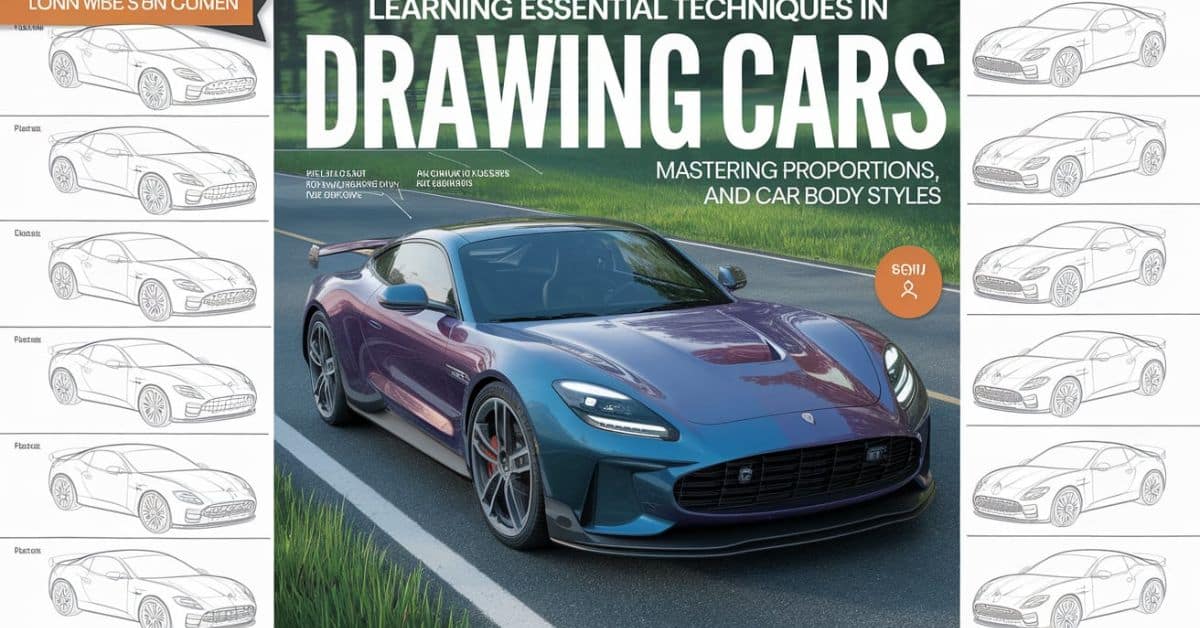Learn essential techniques for drawing = a car, mastering proportions, shading, and car body styles to create lifelike, detailed car designs with this comprehensive guide tailored for beginners and experts.
Whether you’re an aspiring artist or a car enthusiast, this guide is crafted to help you elevate your car drawings to a professional level.
Understanding Car Body Styles – See The Variety!
Before diving into the technical aspects, it’s essential to understand different car body styles as they directly influence your drawings’ structure, proportions, and aesthetics. Each style brings unique design elements that must be captured accurately to bring authenticity to your work.
- Sedan: A balanced structure, often elongated, focusing on proportion.
- SUV: Larger and bulkier, requiring a focus on height and spacious interiors.
- Sports Car: Sleek and low to the ground, emphasising speed lines and aerodynamics.
- Convertible: Features an open-top with intricate roof mechanisms, adding complexity.
- Truck: Known for its robust and helpful structure, enormous proportions and rugged details.
Understanding these fundamentals allows you to capture each style’s unique personality, enhancing your ability to make your drawing realistic and visually compelling.
The Role of Proportions in Car Design – Explore Now!
Proportions are one of the most crucial elements in creating a believable and balanced drawing = car. By ensuring accurate proportions, artists can achieve a realistic and visually harmonious design. Essential proportional guidelines include:
- Wheelbase is the distance between the front and rear wheels. It helps define the car’s length and overall stance.
- Window Placement: Correctly positioning windows gives the car an aerodynamic look and adds symmetry to the drawing.
- Doors and Body Panels: Maintaining proportional doors and panels ensures the car looks structurally accurate.
- Hood and Trunk Length: Adjusting these areas according to body style improves the overall realism.
Tools Needed for Drawing Cars – See The Checklist!
The right tools are essential for creating detailed, high-quality drawings. Here are some critical tools to help with drawing = a car:
- Sketch Pencils: Different graphite pencils (HB, 2B, 4B) for various lines and shading effects.
- Fine Liner Pens: These add precise, detailed lines and final touches.
- Erasers: A kneaded eraser helps create highlights, while a standard eraser corrects mistakes.
- Blending Tools: Blending stumps and tortillons are great for smooth shading.
- Rulers and Templates: Ensure perfect lines and symmetry in your car design.
Essential Techniques for Drawing = Car – Here For You!
Outlining the Car’s Structure:
Sketch the basic shapes, like rectangles and ovals, to outline the car’s body. This approach helps set the foundation for the overall structure.
Defining Proportions:
Use reference images or blueprints of the car style you’re drawing. Mark the wheelbase and establish the car’s height and length to maintain proportionate dimensions.
Adding Curves and Lines:
Cars often feature elegant curves, especially around the hood, windows, and trunk. Smooth out your initial outline with flowing curves to capture the car’s aerodynamic shape.
Detailing Key Elements:
Add details like headlights, grills, and mirrors. Each element must align with the body style to maintain harmony in the drawing.
Mastering Shading and Highlights – Become A Pro!
Shading gives depth and realism to car drawings. Here are some advanced techniques to improve shading for drawing = car:
- Basic Shading: Light shading establishes the car’s base colour.
- Reflections: Incorporate reflections to mimic the metallic nature of car surfaces.
- Depth with Shadows: Darken areas under the wheel wells, beneath the car, and around body curves.
- Highlighting: Use an eraser to add highlights along the edges and curved surfaces, giving the car a polished look.
Adding Depth and Detail – Add Some More!
Add elements like the car’s interior details, emblems, and tyre treads to make your drawing lifelike. Emphasise intricate information such as:
- Grills and Bumpers: Carefully outline and shade to give these elements depth.
- Headlights: Add reflections and multiple layers to create a realistic lighting effect.
- Wheels and tyres: Draw treads on the tyres and shade the wheels for a 3D effect.
Common Mistakes and How to Avoid Them – Must Follow!
Many artists encounter common issues when drawing = a car. Here’s how to avoid them:
- Overcomplicating Proportions: Keep your proportions simple and accurate.
- Inconsistent Lines: Use consistent pressure when outlining to maintain a uniform look.
- Neglecting Shadows: Shadows add depth, so don’t skip them. Ensure they align with your light source.
Practice Exercises for Improving Car Drawing Skills –
Regular practice will help you refine your car drawing skills. Try these exercises:
- Proportion Practice: Draw cars in varying perspectives to master proportions.
- Shading Drills: Practice shading with different lighting angles.
- Detail Focus: Choose a specific car part, like headlights, and practice drawing it in detail.
Frequently Asked Questions:
What are the best pencils for drawing = a car?
For general outlines, an HB pencil works well. Use 2B for shading and 4B for darker lines and accents.
How can I improve my shading technique for cars?
Study light and reflection sources. Practice layering light, medium, and dark shades to achieve realistic depth.
How do I add realism to my car drawing?
Focus on accurate proportions and use shading to add depth and details like reflections and tyre textures.
Conclusion:
Mastering the art of drawing = a car requires patience, attention to detail, and understanding essential techniques like proportions and shading.
By practising these methods and experimenting with different body styles, you can develop the skills to create realistic and visually stunning car drawings.






